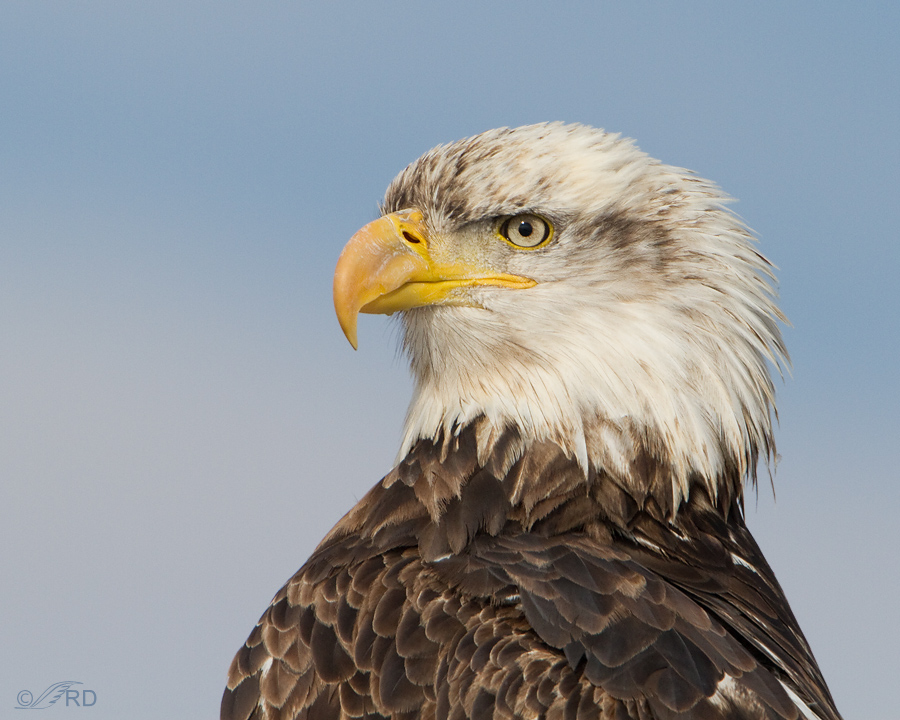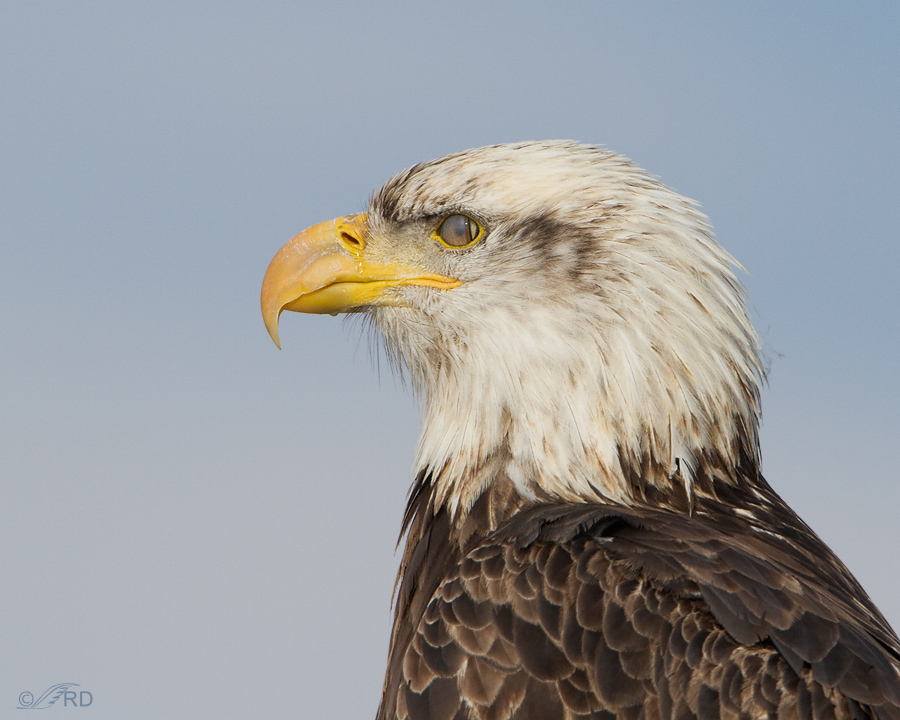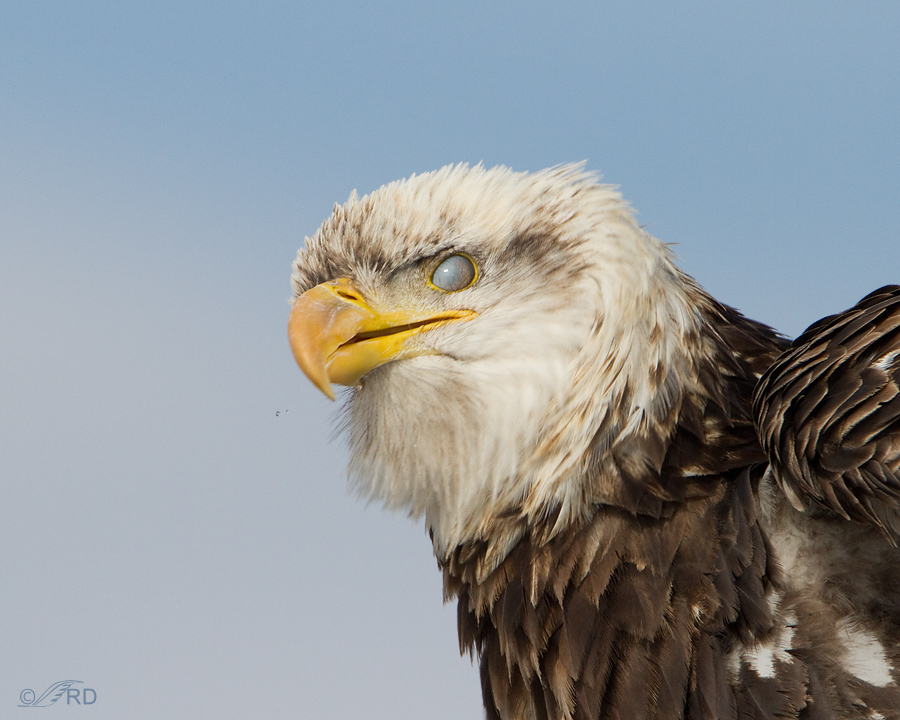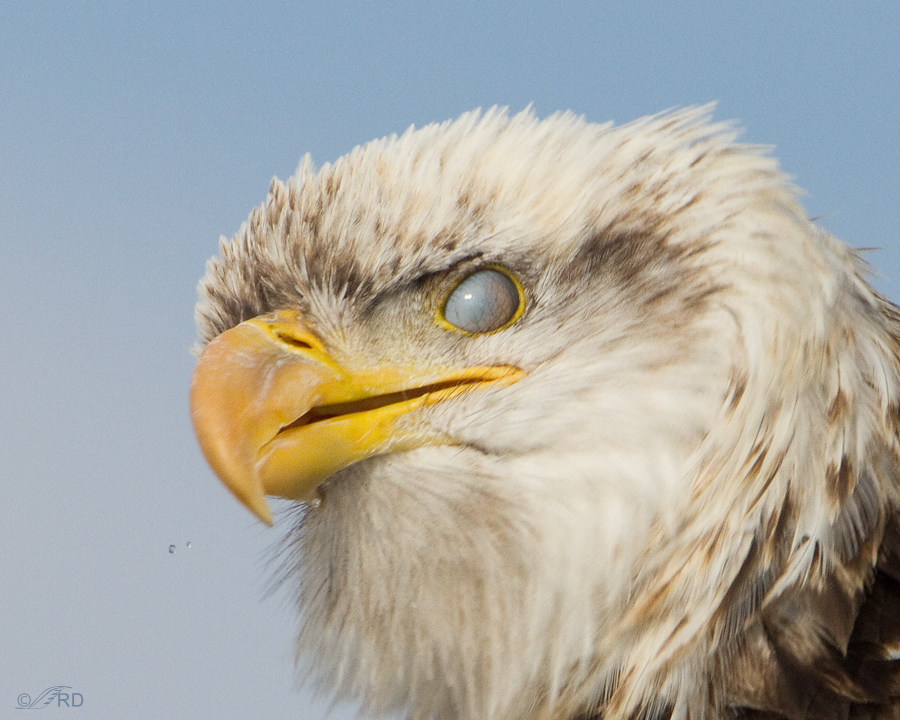The nictitating membrane (nictitan) is a membrane or “third eyelid” found in some vertebrates that can be drawn across the eye for protection and to moisten and lubricate the surface of the eye. It is either translucent or semi-transparent so the animal maintains sight while it covers the eye. Birds, sharks and some reptiles have a fully functional nictitating membrane while in most mammals there is only a small vestigial remnant in the corner of the eye. However camels, polar bears, seals, aardvarks, marsupials and monotremes do have fully functional membranes.
1/2000, f/8. ISO 500, 500 f/4, 1.4 tc
This nearly adult (head not yet completely white) Bald Eagle is neither tame or captive. But for several days in 2009, beginning on a bitterly cold Christmas morning, this adult adopted a favorite perch (a relatively short pole) that looked out over a pond with fish in it. The pole was so close to the road that I sometimes had to take off my teleconverter to get the entire bird in the frame. It warmed my heart that the eagle was so comfortable with me this close and that was a very good thing because Mia and I almost froze to death over the many hours of photographing this magnificent bird.
This is the normal appearance of the Bald Eagle’s eye. In adult birds, eye color is typically some shade of yellow with a distinctly visible pupil (though juvenile birds have much darker eyes).
1/2000, f/8. ISO 500, 500 f/4, 1.4 tc
But every few seconds the bird swipes the nictitating membrane across the eye to moisten and lubricate it. It begins at the inside corner of the eye closest to the beak and moves across to the outside corner. Here the membrane is almost completely closed. It happens very quickly and I needed a fast shutter speed to freeze it.
1/2500, f/8. ISO 500, 500 f/4, 1.4 tc
In this image the membrane completely covers the eye but it’s obvious that the eagle still has its vision because we can still see the pupil through the nictitan.
1/3200, f/7.1. ISO 500, 500 f/4, 1.4 tc
At certain light angles the membrane can appear opaque to us, as in this shot taken while the eagle was in the midst of a violent head shake (you can see a few drops of moisture being thrown off the bill). This is the dreaded “steel eye” referred to by us bird photographers – “dreaded” because the effect is generally undesirable in nature photography and seems to invariably happen in an otherwise spectacular shot. For some reason, steel eye seems to occur much more often in particular species of birds – magpies and ravens for example. Perhaps it has something to do with the reflective nature of the outside of the membrane of these species but that’s a “stab in the dark” on my part…
1/3200, f/7.1. ISO 500, 500 f/4, 1.4 tc
Here’s a tighter crop of the previous image to show better detail in the nictitan. You can clearly see the network of nourishing blood vessels embedded in the membrane. And as a photographer I note that I even got a catch light on the membrane, provided by the sun rising over the mountains behind me.
This kind of stuff still fascinates me even though I retired from teaching zoology several years ago.
Ron







Thanks for sharing your knowledge…your site was posted on the Norlfolk Botanical eagle cam site today……….there are many questions about the eyes of the eagles. I can’t wait to come back and really explore your entire site.thanks again
Thanks Jo Ann. I’m glad that the eye info was helpful.
Wow
Great shot
Thanks for continuing to teach
Laura, I really like that shot because it combines a good look at the membrane with grooming behavior. You got double your moneys worth on that one. Interesting species too.
Amazing shots!
I’m very much enjoying your blog and your work. I thought you might be interested in this photo of the nictitating membrane on a Galapagos Hawk:
http://www.flickr.com/photos/19474221@N08/4379763627/in/set-72157623369186631/lightbox/
The blood vessels are clearly visible in a tight crop in this one.
Truly fascinating. Thank you so much.